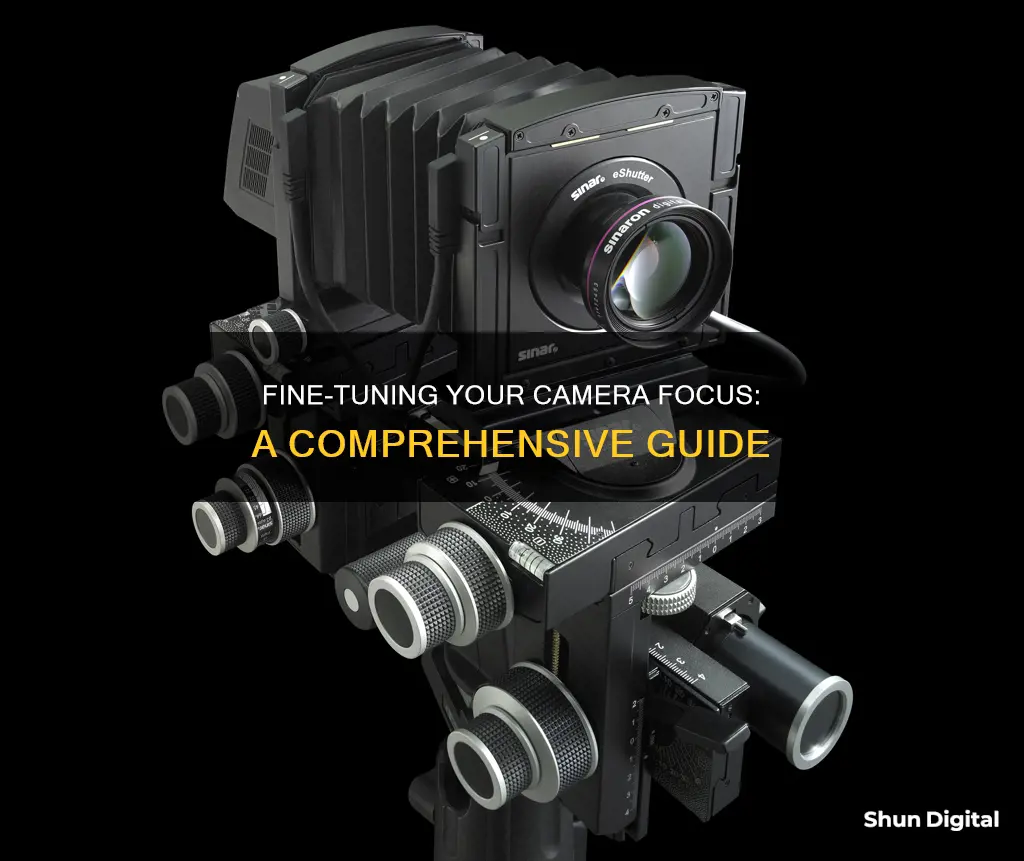
Determining the fine focus of a camera is essential to achieving sharp images and eliminating blurriness. This process, known as calibrating the lens, is necessary when the autofocus system of a camera fails to deliver precise results. Various factors, such as manufacturing defects, insufficient quality assurance, or improper handling, can contribute to autofocus issues. To fine-tune the focus, photographers can utilise tools like focus charts, which provide targets for the camera to lock onto and help identify the correct depth of field. Modern cameras also offer built-in autofocus calibration features, such as AF Fine Tune in Nikon cameras and AF Microadjustment in Canon cameras. These settings allow for incremental adjustments to compensate for back-focus or front-focus issues, ensuring the camera captures the desired image with clarity.
| Characteristics | Values |
|---|---|
| Purpose | To help achieve the best focus for your camera, especially when experiencing a shallow field depth |
| Target | A target for the camera to lock onto |
| Zoom | Provides several different areas to zoom in on to get the precise focus |
| Autofocus | Assists with testing a camera's autofocus |
| Calibration | Aids with calibrating lenses |
| Chromatic Distortions | Determines whether your camera or lens has any chromatic distortions |
| Environment | More common in conditioned studio environments |
| Lighting | Essential when shooting inanimate objects and in dim light |
| Shallow Focus | Vital when you want a shallow focus on your subject, with the background being blurry |
| DIY | It is possible to auto-focus a lens or camera body without requiring additional tools |
| Camera Settings | To correct the camera's focus, click on "AF", followed by "AF Micro Adjustment." Scroll down and select "Adjust by Lens." |
| Graph | A graph should be visible, which can be used to pull back your camera focus or zoom it out |
What You'll Learn

Use a focus chart to test autofocus and calibrate lenses
A focus chart is a target for your camera to lock onto. It helps you get the best focus possible, especially when you have a shallow depth of field. It is also useful when testing your camera's autofocus and calibrating your lenses.
To use a focus chart to test autofocus and calibrate lenses, follow these steps:
Setting up the Focus Chart:
- Print a focus chart on regular letter-sized paper. You can find free charts online.
- Tape the focus chart to a wall at eye level. Ensure the wall is vertical and straight.
- Set up your camera on a tripod parallel to the focus chart. Adjust the distance between the camera and the wall depending on the focal length of the lens you are testing. For a 50mm lens, the distance should be approximately 5 to 7 feet.
Camera Settings:
- Switch your camera to full Manual Mode.
- Set your lens aperture to the maximum aperture (e.g., f/1.8 for a Nikon 50mm f/1.8G lens).
- Set your ISO to a base value, such as ISO 100.
- Use the exposure meter inside the camera to determine the optimal shutter speed. Aim for a fast shutter speed (e.g., 1/500 of a second). Ensure you have sufficient ambient light.
- Turn off any lens corrections in your camera (e.g., vignetting, distortion, chromatic aberration).
- Set the camera to AF-S/Single Servo mode.
- If your camera has a Mirror Lock-Up feature and you have a remote camera release, use them to prevent camera shake.
Capturing Test Images:
- Capture the focus chart in Live View mode. This will be your reference shot. Zoom in on the center of the focus chart and half-press the shutter or press the AF-ON button to force the lens to focus. Capture the image and analyze it at 100% view to ensure it is sharp in the center.
- Capture additional images without Live View. Look through the viewfinder and rotate the focus ring until the focus chart is out of focus. Half-press the shutter button or press AF-ON to acquire focus again. Capture at least three shots to eliminate any possibility of autofocus error.
Analyzing the Results:
- Import the images into your computer and open the reference image. Ensure it looks sharp in the center.
- Compare the reference image with the other captured images. If they all look out of focus, there is a focus problem with either the lens or the camera body.
- If you have multiple lenses, test each lens to determine whether the issue is with the camera or a specific lens.
Adjusting the Focus:
- Go into your camera's menu and turn on AF Fine Tune/AF Micro Adjustment if available.
- Adjust the focus settings based on the results of your test images. For example, if the images exhibit back focus, adjust the focus to pull the plane of focus closer. Conversely, if the images exhibit front focus, adjust the focus to push the plane of focus farther away.
- Capture additional images and analyze them to fine-tune the focus settings until you achieve the desired sharpness.
By following these steps and using a focus chart, you can accurately test the autofocus of your camera and calibrate your lenses to ensure sharp and focused images.
Displaying Gridlines: Camera Raw's Secret Weapon
You may want to see also

Adjust autofocus on your camera without a back focus chart
If you are in a bind and don't have a back focus test chart, you can still auto-focus your camera without any additional tools. You will need to recalibrate your camera to maintain a sharp focus. Here are the steps to do this:
Set up your target area
- Create your own camera focus calibration chart by drawing a thin line on a poster board.
- Place this poster board on a table, ensuring that it doesn't move.
Place rulers next to the line
- Once your camera has focused on the line, set up two rulers on either side of the line.
- Be careful not to move anything on the table as you set up the rulers.
- The rulers should each touch the line at the same measurement, for example, both at the 20cm point.
Take a picture
- Take a picture of your setup.
- If some of the numbers on the ruler are sharper than the line, it means your camera's autofocus is drawn too far away from the centre.
Go into your camera's menu
- To correct this, go into your camera's menu and select "AF", then "AF Micro Adjustment".
- Next, select "Adjust by Lens".
- A graph should appear, which you can use to pull the focus back or span it out depending on how the image turned out.
Take another picture and adjust as needed
- Take another picture after altering the focus.
- If the line is now in focus, you're done!
- If not, go back into the camera's settings and continue adjusting until you achieve the desired result.
While this DIY method is useful, it is recommended to get a lens calibration focus chart for professional shoots requiring high-resolution images.
Unlocking Manual Mode: How to Identify Camera Settings
You may want to see also

Use a lens calibration chart to achieve a shallow focus
Using a lens calibration chart is an excellent way to achieve a shallow focus for your images. This process is especially useful when you want your subject to be in sharp focus while the background is blurry. Here are the steps you can follow to achieve shallow focus using a lens calibration chart:
Set Up Your Equipment:
- Place your camera on a sturdy tripod or a stable surface. Ensure that your camera is level and doesn't move during the calibration process.
- Set up your lens calibration chart at the desired distance. It is recommended to calibrate at a distance of approximately 25 times the focal length of your lens. For example, if you have an 85mm lens, calibrate at a distance of around 7 feet (2.1 meters). However, any distance between 5 and 50 times the focal length is suitable.
- Ensure that your camera settings are correct. Set your lens to its widest aperture to achieve a shallow depth of field, which will make it easier to determine the focus accuracy. Set your camera to autofocus mode and turn off Live View, as it uses a different autofocus system.
Calibration Process:
- Focus on the centerline or the target of your lens calibration chart through the viewfinder. Ensure that the chart fills up your entire camera frame.
- Take a test shot. Review the image by zooming in to determine where the camera's focus falls. You can identify the sharpest areas and whether the focus is in front of or behind your target.
- Adjust your camera's autofocus settings accordingly. Most cameras will have an autofocus micro-adjustment or fine-tune setting. Make small adjustments and take multiple test shots until you achieve the desired focus.
Additional Tips:
- It is important to calibrate each lens you own on all your cameras, as the changes are made on the camera body and not the lens.
- Calibration may vary by distance. Test your calibration at different distances to ensure consistent results.
- Periodically recalibrate your lenses, especially after heavy use. Over time, internal components can shift, causing your photos to become slightly blurry.
- If you encounter erratic focus issues, where you get front-focus and back-focus issues inconsistently, it is best to send your camera and lens for professional service.
- Some third-party lenses offer USB docks for more extensive calibration options. However, this is usually an advanced procedure left to professionals.
By following these steps and tips, you can effectively use a lens calibration chart to achieve a shallow focus for your images, ensuring that your subject is in sharp focus while the background blurs pleasantly.
Dual Camera Mode: Capturing the World in New Ways
You may want to see also

Understand the hyperfocal distance for maximum sharpness
Understanding hyperfocal distance is key to achieving maximum sharpness in your photographs. Hyperfocal distance is the focusing distance that gives your photos the greatest depth of field. In other words, it is the distance from a lens beyond which all objects can be brought into an "acceptable" focus. It is particularly useful in landscape photography, helping you to make the most of your depth of field and produce a more detailed final image.
The hyperfocal distance is defined as the focus distance that places the furthest edge of a depth of field at infinity. If you focus any closer than this, the distant background will appear unacceptably soft. Conversely, if you focus any farther than this, the most distant portion of the depth of field will be wasted.
The hyperfocal distance is entirely dependent on what level of sharpness is considered acceptable. The definition of "acceptable sharpness" is specified through the circle of confusion (CoC) diameter limit, which is the largest acceptable spot size diameter that an infinitesimal point is allowed to spread out to on the imaging medium (film, digital sensor, etc.).
The hyperfocal distance has a unique property called "consecutive depths of field". When a lens is focused at an object at the hyperfocal distance, the depth of field will extend from half that distance to infinity. If the lens is then focused to half of that distance, the depth of field will extend from one-third of the original distance to the full distance, and so on.
While knowing the hyperfocal distance for a given focal length and aperture can be tricky, there are several methods to determine it. These include using a hyperfocal distance chart, a focusing scale on your lens, or more simple methods like the "Double the Distance" method or the "Live View Infinity Focus" method.
By understanding and utilising the hyperfocal distance, you can ensure that your photographs, especially landscapes, have maximum sharpness and depth of field.
Where to Buy Camera Batteries: Walgreens and Beyond
You may want to see also

Use manual focus for quick judgement or limited depth of field
Manual focus is a great way to quickly judge the focus of your image or to achieve a limited depth of field.
Manual focus is faster than autofocus in good lighting conditions, as it allows you to shoot at a higher f-stop, increasing the depth of field and meaning you don't need to focus exactly on the subject. With practice, you can quickly guess the best focus with speed and accuracy. You can also use zone focusing, which involves selecting a 'zone' between various focus ranges, and then positioning yourself so that the subject is within that range.
You can also use a technique called hyper-focal distance. This involves setting the focus such that everything beyond a certain distance is in focus. For example, if you set the aperture to f/11 and the focus to 5m, everything from 5m to infinity will be in focus.
Manual focus is especially useful for street photography, where the moment you're trying to capture may be fleeting. It's also useful for situations where autofocus might struggle, such as when shooting from the hip, or when the subject is erratic (such as in sports photography).
Understanding Vibrance Slider: Enhancing Your Photos in Camera Raw
You may want to see also
Frequently asked questions
If the focusing is accurate, the point on the image that corresponds to the number 0 on the lens calibration chart should be the sharpest spot on the image. The other numerals should become increasingly blurry as you move away from the '0'.
A camera focus chart is a tool that helps you to achieve an accurate focus. It can be used for both film and digital cameras. A camera focus chart has different types of lines on it that represent various focal distances, which are typically in feet and inches.
You start by putting the chart in front of your camera. It should fill up the entire frame. From there, you can see if your camera lens has a consistently sharp focus across the frame or if it becomes blurry in certain areas.







